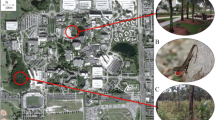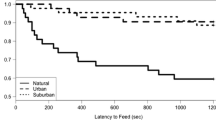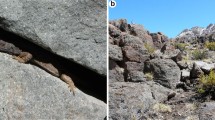Abstract
The fragmentation of landscapes produces habitat gaps where the distance between visual landmarks may exceed the perceptual range of a species and impose navigational constraints. We estimated the visual perceptual range of the Australian sleepy lizard, Tiliqua rugosa, by releasing individuals in the centre of a cleared arena in high temperature conditions, with a 0.5-m-high bush placed either 10, 20 or 30 m from the release site. Lizards were more likely to locate those bushes and shelter under them when they were closer, and no lizards found a bush at 30 m. In addition, lizards were less likely to move from the release point when bushes were at 30 m than when they were at the two closer distances. These data suggest that for sleepy lizards the perceptual range for a 0.5-m-high bush is about 20 m. In the uncleared chenopod shrub-land where these lizards live, suitable shelter bushes are an average of 10.5 m from any point in their home range, well within their perceptual range.
Similar content being viewed by others
References
Andreassen HP, Bjørnbom E, Carlsen RG, Gündersen G, Gundersen H (1998) Visual cues as determinants of perceptual range in root voles, Microtus oeconomus. Acta Theriol 43:371–378
Bruce V, Green PR, Georgeson MA (2003) Visual perception: physiology, psychology and ecology, 4th edn. Psychology Press, New York
Bull CM (1987) A population study of the viviparous Australian lizard Trachydosaurus rugosus (Scincidae). Copeia 1987:749–757
Bull CM (1988) Mate fidelity in an Australian lizard Trachydosaurus rugosus. Behav Ecol Sociobiol 23:45–49
Bull CM (1995) Population ecology of the sleepy lizard, Tiliqua rugosa, at Mt Mary, South Australia. Aust J Ecol 20:393–402
Bull CM, Baghurst BC (1998) Home range overlap of mothers and their offspring in the sleepy lizard, Tiliqua rugosa. Behav Ecol Sociobiol 42:357–362
Bull CM, Bedford GS, Schulz BA (1993) How do sleepy lizards find each other? Herpetol 49:294–300
Bull CM, Freake MJ (1999) Home range fidelity in the Australian sleepy lizard, Tiliqua rugosa. Aust J Zool 47:125–132
Bull CM, Lindle C (2002) Following trails of partners in the monogamous lizard, Tiliqua rugosa. Acta Ethol 5:25–28
Bull CM, Pamula Y (1996) Sexually dimorphic head sizes and reproductive success in the sleepy lizard Tiliqua rugosa. J Zool 240:511–521
Crescitelli F (1972) The visual cells and the visual pigments of the vertebrate eye. In: Dartnall HJA (ed) Photochemistry of vision. Springer, Berlin Heidelberg New York, pp 245–263
Downes S, Shine R (1998) Heat, safety or solitude? Using habitat selection experiments to identify a lizard’s priorities. Anim Behav 55:1387–1396
Firth BT, Belan I (1998) Daily and seasonal rhythms in selected body temperature in the Australian lizard Tiliqua rugosa (Scincidae): field and laboratory observations. Physiol Zool 71:303–311
Freake MJ (1996) Orientation in the Australian sleepy lizard Tiliqua rugosa. PhD Thesis, Flinders University, South Australia
Freake MJ (1998) Variation in homeward orientation performance in the sleepy lizard (Tiliqua rugosa): effects of sex and reproductive period. Behav Ecol Sociobiol 43:339–344
Freake MJ (1999) Evidence for orientation using the e-vector direction of polarised light in the sleepy lizard Tiliqua rugosa. J Exp Biol 202:1159–1166
Freake MJ (2001) Homing behaviour in the sleepy lizard (Tiliqua rugosa): the role of visual cues and the parietal eye. Behav Ecol Sociobiol 50:563–569
Gillis EA, Nams VO (1998) How red-backed voles find habitat patches. Can J Zool 76:791–794
Goodwin BJ, Bender DJ, Contreras TA, Fahrig L, Wegner JF (1999) Testing for habitat detection distances using orientation data. Oikos 84:160–163
Gruber B, Henle K (2004) Linking habitat structure and orientation in an arboreal species Gehyra variegata (Gekkonidae). Oikos 107:406–414
How TL, Bull CM (2002) Reunion vigour: an experimental test of the mate guarding hypothesis in the monogamous sleepy lizard, Tiliqua rugosa. J Zool 257:333–338
Keister AR, Gorman GC, Arroyo D (1975) Habitat selection behaviour of three species of Anolis lizard. Ecology 56:220–225
Kerr GD, Bull CM (2004) Microhabitat use by the scincid lizard Tiliqua rugosa: exploiting natural temperature gradients beneath plant canopies. J Herpetol 38:536–545
Kerr GD, Bull CM (2006a) Exclusive core areas in overlapping ranges of the sleepy lizard, Tiliqua rugosa. Behav Ecol 17:380–391
Kerr GD, Bull CM (2006b) Interactions between climate, host refuge use, and tick population dynamics. Parasitol Res 99:214–222
Kerr GD, Bull CM (2006c) Movement patterns in the monogamous sleepy lizard (Tiliqua rugosa): effects of gender, drought, time of year and time of day. J Zool 269:137–147
Kerr GD, Bull CM, Burzacott D (2003) Refuge sites used by the scincid lizard Tiliqua rugosa. Austral Ecol 28:152–161
Lima SL, Zollner PA (1996) Towards a behavioural ecology of ecological landscapes. Trends Ecol Evolut 11:131–135
Mech SG, Zollner PA (2002) Using body size to predict perceptual range. Oikos 98:47–52
Olden JD, Schooley RL, Monroe JB, Poff NL (2004) Context dependent perceptual ranges and their relevance to animal movements in landscapes. J Anim Ecol 73:1190–1194
Satrawaha R, Bull CM (1981) The area occupied by an omnivorous lizard, Trachydosaurus rugosus. Aust Wildl Res 8:435–442
Schooley RL, Wiens JA (2003) Finding habitat patches and directional connectivity. Oikos 102:559–570
Shah B, Shine R, Hudson S, Kearney M (2004) Experimental analysis of retreat site selection by thick tailed geckoes Nephurus milli. Austral Ecol 29:547–552
Spellerberg IF (1972) Temperature tolerances of southeast Australian reptiles examined in relation to reptile thermoregulatory behaviour and distribution. Oecol 9:23–46
Stanley MC (1998) Homing in the skink, Oligosoma grande, within a fragmented habitat. J Herpetol 32:461–464
Warburg MR (1965) The influence of ambient temperature and humidity on the body temperature and water loss from two Australian lizards, Tiliqua rugosa (Gray) (Scincidae) and Amphibolurus barbarus Cuvier (Agamidae). Aust J Zool 13:331–350
Webb JK, Pringle RM, Shine R (2004) How do nocturnal snakes select diurnal retreat sites? Copeia 2004:919–925
Zeil J, Hemmi J (2006) Visual ecology of fiddler crabs. J Comp Physiol A 192:1–25
Zollner PA (2000) Comparing landscape level perceptual abilities of forest sciurids in fragmented agricultural landscapes. Landscape Ecol 15:523–533
Zollner PA, Lima SL (1997) Landscape-level perceptual abilities in white-footed mice: perceptual range and the detection of forested habitat. Oikos 80:51–60
Zollner PA, Lima SL (1999a) Illumination and the perception of remote habitat patches by white-footed mice. Anim Behav 58:489–500
Zollner PA, Lima SL (1999b) Search strategies for landscape-level interpatch movements. Ecology 80:1019–1030
Zollner PA, Lima SL (2005) Behavioural tradeoffs when dispersing across a patchy landscape. Oikos 108:219–230
Zuri I, Bull CM (2000) The use of visual cues for spatial orientation in the sleepy lizard, Tiliqua rugosa. Can J Zool 78:515–520
Acknowledgments
We thank Ron and Leona Clark for allowing us access to their land and use of the homestead at Bundey Bore Station. Dale Burzacott and Toby Galligan helped with the field work. The study was conducted according to the guidelines of the Flinders University Animal Welfare Committee in compliance with the Australian Code of Practice for the use of animals for scientific purposes. The Australian Research Council and School of Biological Sciences, Flinders University, funded this research.
Author information
Authors and Affiliations
Corresponding author
About this article
Cite this article
Auburn, Z.M., Bull, C.M. & Kerr, G.D. The visual perceptual range of a lizard, Tiliqua rugosa . J Ethol 27, 75–81 (2009). https://doi.org/10.1007/s10164-008-0086-z
Received:
Accepted:
Published:
Issue Date:
DOI: https://doi.org/10.1007/s10164-008-0086-z




